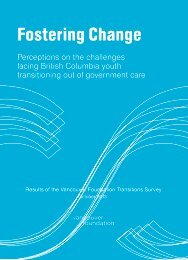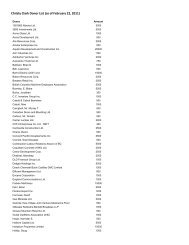from the ground up - The Tyee
from the ground up - The Tyee
from the ground up - The Tyee
Create successful ePaper yourself
Turn your PDF publications into a flip-book with our unique Google optimized e-Paper software.
tec, who designed and built <strong>the</strong> school, decided thiswasn’t enough to get <strong>the</strong> energy-saving benefits ofnatural light, and opted to go with three times as manywindows for <strong>the</strong> school.But it wasn’t just to save energy -- <strong>the</strong>y were alsoaware that natural light just looks nicer than artificial.“This is a fantastic school for access to daylight,” saysRebecca Holt, sustainability specialist for Stantec.“I think being able to see what’s going on outside andhave real daylight ra<strong>the</strong>r than artificial light makes fora much nicer quality, too.”<strong>The</strong> pleasing aes<strong>the</strong>tics of natural light is an area JenniferVeitch has devoted her career to studying.“In a space that is well day-lit we have better knowledgeof what’s going on outside and a connection,both to <strong>the</strong> passage of time and to exterior conditions,so you know if it’s cloudy or sunny, is it raining orwhat-not, and people like that sense of connectivenessto <strong>the</strong> outdoors,” says Veitch, a senior researchofficer in lighting for <strong>the</strong> National Research Council’sInstitute for Research in Construction.Veitch studies <strong>the</strong> effects of office lighting on people,and says many report feeling healthier when exposedto natural light, as compared to electric light. Shecites a 2003 study by <strong>the</strong> Heschong Mahone Gro<strong>up</strong>,a California-based green-building consultant firm,which found elementary school classrooms with <strong>the</strong>most daylight saw a 21 per cent improvement in productivitycompared to students in classrooms that hadno daylight.Fellow lighting researcher Mark S. Rea of <strong>the</strong> RensselaerPolytechnic Institute conducted research in2010 in North Carolina where Grade 8 students woreorange, short-wave light-blocking glasses to schoolone week, and not <strong>the</strong> next week. When students wore<strong>the</strong> glasses <strong>the</strong>ir sleep onset was delayed, and <strong>the</strong>yweren’t getting adequate sleep to prepare <strong>the</strong>m forschool.“<strong>The</strong> results presented here are <strong>the</strong> first to show,outside laboratory conditions, that removal of shortwavelengthlight in <strong>the</strong> morning hours can delayDLMO in 8th-grade students. <strong>The</strong>se field data, consistentwith results <strong>from</strong> controlled laboratory studies,are directly relevant to lighting practice in schools,”reads <strong>the</strong> study.Brea<strong>the</strong> easierPart of attaining LEED Silver status means using materialswith low volatile organic compounds (VOCs)only. Everything <strong>from</strong> <strong>the</strong> glue, to <strong>the</strong> paint, to anycoatings could only have a certain amount of VOCs-- which cause everything <strong>from</strong> “new paint smell” toeye irritation and respiratory problems -- before pointswould be deducted.“Essentially you get very, very little off-gassing, andit protects <strong>the</strong> people who are applying <strong>the</strong> products,as well as <strong>the</strong> people who are living in <strong>the</strong> buildingafter that,” says Holt.Ano<strong>the</strong>r credit required a two-week flushing of <strong>the</strong>ventilation system using outside air, flushing out anyconstruction materials, emissions or dust left behind,before anyone could enter <strong>the</strong> building.“It makes for a much, much better indoor environment.And you just don’t get that smell that you dowhen you get fresh paint and you come into a newbuilding, that smell you’re getting is VOCs,” Holttold <strong>The</strong> <strong>Tyee</strong>.Green buildings weren’t always known for <strong>the</strong>ir pristineair quality. Efforts to make more energy-efficientbuildings in <strong>the</strong> 1970s resulted in airtight buildings,where designers attempted to prevent any air <strong>from</strong>escaping <strong>the</strong> building in order to save on heating andcooling, but didn’t allow for <strong>the</strong> circulation of cleanair to brea<strong>the</strong>. This was known as “sick building syndrome.”“What <strong>the</strong>y did was <strong>the</strong>y were trying to reduce infiltrationrates, and <strong>the</strong>re are changes per hour, so <strong>the</strong>ysealed <strong>the</strong>m very tight. But <strong>the</strong>n of course nobodycould brea<strong>the</strong>,” says John Robinson, executive directorof <strong>the</strong> UBC sustainability initiative.“<strong>The</strong> department of <strong>the</strong> environment buildings inHull, Quebec, were at a place called Les Terrasses dela Chaudiere, I believe, and anyway <strong>the</strong> joke was LeTerrace de Shoddy Air, because <strong>the</strong> air quality was sobad.”56








